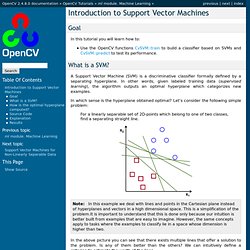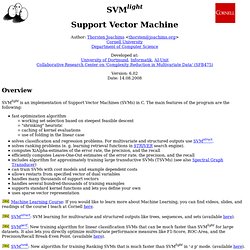

A Library for Support Vector Machines. LIBSVM -- A Library for Support Vector Machines Chih-Chung Chang and Chih-Jen Lin Version 3.20 released on November 15, 2014.

It conducts some minor fixes. LIBSVM tools provides many extensions of LIBSVM. Please check it if you need some functions not supported in LIBSVM. We now have a nice page LIBSVM data sets providing problems in LIBSVM format. A practical guide to SVM classification is available now! To see the importance of parameter selection, please see our guide for beginners. Using libsvm, our group is the winner of IJCNN 2001 Challenge (two of the three competitions), EUNITE world wide competition on electricity load prediction, NIPS 2003 feature selection challenge (third place), WCCI 2008 Causation and Prediction challenge (one of the two winners), and Active Learning Challenge 2010 (2nd place). Introduction. Demystifying Support Vector Machines for Beginners: A Reading List. Though I have worked on pattern recognition in the past I have always wanted to work with Neural Networks for the same.

However for some reason or the other I could never do so, I could not even take it as an elective subject due to some constraints. Over the last two years or so I have been promising myself and ordering myself to stick to a schedule and study ANNs properly, however due to a combination of procrastination, over-work and bad planning I have never been able to do anything with them. However I have now got the opportunity to work with Support Vector Machines and over the past some time I have been reading extensively on the same and have been trying to get playing with them.
Now that the actual implementation and work is set to start I am pretty excited to work with them. It is nice that I get to work with SVMs though I could not with ANNs. Support Vector Machine is a classifier derived from statistical learning theory by Vladimir Vapnik and his co-workers. 1. 2. 3. TinySVM: Support Vector Machines. Last update: $Date: 2002/08/20 06:14:22 $ TinySVM TinySVM is an implementation of Support Vector Machines (SVMs) [Vapnik 95], [Vapnik 98] for the problem of pattern recognition.

Support Vector Machines is a new generation learning algorithms based on recent advances in statistical learning theory, and applied to large number of real-world applications, such as text categorization, hand-written character recognition. List of Contents What's new 2002-08-20: TinySVM 0.09 Released Fix bug in -W option Support Intel C++ compiler for Linux 6.0 (e.g. Fast Training of Support Vector Machines Using Sequential Minimal Optimization. Fast Training of Support Vector Machines Using Sequential Minimal Optimization John C.

Platt January 1998 This chapter describes a new algorithm for training Support Vector Machines: Sequential Minimal Optimization, or SMO. Training a Support Vector Machine (SVM) requires the solution of a very large quadratic programming (QP) optimization problem. SMO breaks this QP problem into a series of smallest possible QP problems.
Smo-book. School of Engineering - Stanford Engineering Everywhere. Introduction to Support Vector Machines. What is a SVM?

A Support Vector Machine (SVM) is a discriminative classifier formally defined by a separating hyperplane. In other words, given labeled training data (supervised learning), the algorithm outputs an optimal hyperplane which categorizes new examples. In which sense is the hyperplane obtained optimal? Let’s consider the following simple problem: For a linearly separable set of 2D-points which belong to one of two classes, find a separating straight line. Note In this example we deal with lines and points in the Cartesian plane instead of hyperplanes and vectors in a high dimensional space. In the above picture you can see that there exists multiple lines that offer a solution to the problem. A line is bad if it passes too close to the points because it will be noise sensitive and it will not generalize correctly. Then, the operation of the SVM algorithm is based on finding the hyperplane that gives the largest minimum distance to the training examples. Where as the bias. See also.
SVM-Light Support Vector Machine. Overview SVMlight is an implementation of Support Vector Machines (SVMs) in C.

The main features of the program are the following: fast optimization algorithm working set selection based on steepest feasible descent "shrinking" heuristic caching of kernel evaluations use of folding in the linear case solves classification and regression problems. Machine Learning Course: If you would like to learn more about Machine Learning, you can find videos, slides, and readings of the course I teach at Cornell here. SVMstruct: SVM learning for multivariate and structured outputs like trees, sequences, and sets (available here). SVMperf: New training algorithm for linear classification SVMs that can be much faster than SVMlight for large datasets.
SVMrank: New algorithm for training Ranking SVMs that is much faster than SVMlight in '-z p' mode. Description The software also provides methods for assessing the generalization performance efficiently. Source Code and Binaries. SVM. Jason_svm_tutorial.